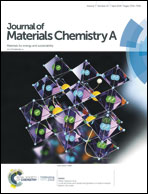A bimetallic Au–Ag nanoalloy mounted LDH/RGO nanocomposite: a promising catalyst effective towards a coupled system for the photoredox reactions converting benzyl alcohol to benzaldehyde and nitrobenzene to aniline under visible light
Abstract
Achieving organic transformation reactions using green synthesis methods under mild conditions is always an aspiration of scientists. In the present findings, a Zn–Cr layered double hydroxide (LDH)/graphene oxide (GO) nanocomposite modified with Au–Ag noble metal nanoparticles (NPs) was synthesized via the in situ crystallization of a LDH over a GO surface followed by the simultaneous photo-deposition of a metal alloy and the reduction of GO to reduced graphene oxide (RGO) under UV light irradiation, resulting in AuAg@GO/LDH. All prepared samples were suitably analysed via various sophisticated techniques to explore their structural, morphological, optical and compositional behaviours. The characterization outcomes showed the uniform distribution of AuAg alloyed NPs with a typical diameter of around ∼3 nm on the facade of the GO/LDH nanocomposite. The conversion of GO to RGO is confirmed via Raman analysis. This bimetallic alloy-based nanocomposite provides a novel platform for artificial photocatalysis, and shows excellent catalytic activity for the performed tandem redox reactions. The combined effects of the plasmon active AuAg alloy, the visible photon-responsive ZnCr LDH and the electron trapping and transporting properties of GO illustrate the existence of an intensified green photochemical process, which can be extensively developed to be applied to tandem liquid phase photocatalytic organic reactions. Here the photogenerated electrons and holes can be directly utilized by nitrobenzene (NB) and benzyl alcohol (BA) to produce aniline (AL) and benzaldehyde (BAD) via GO, respectively. This selective photoredox reaction is a synergistic type of process that proceeds via producing and consuming protons. The effective separation of charge carriers is well supported by photoluminescence (PL) studies. Compared to the parent GO/LDH and Au and Ag singly-modified GO/LDH samples, AuAg@GO/LDH revealed proficient photocatalytic potential owing to the existence of combined surface plasmon resonance (SPR) effects, characterised through UV-visible diffuse reflectance spectroscopy (UV-vis DRS), generating hot electrons from both photoexcited Au and Ag atoms under visible light illumination. The AuAg@GO/LDH hybrid photocatalyst showed ∼2.5 times better performance than GO/LDH, without any indication of leached metal or metal alloy over five runs.



 Please wait while we load your content...
Please wait while we load your content...